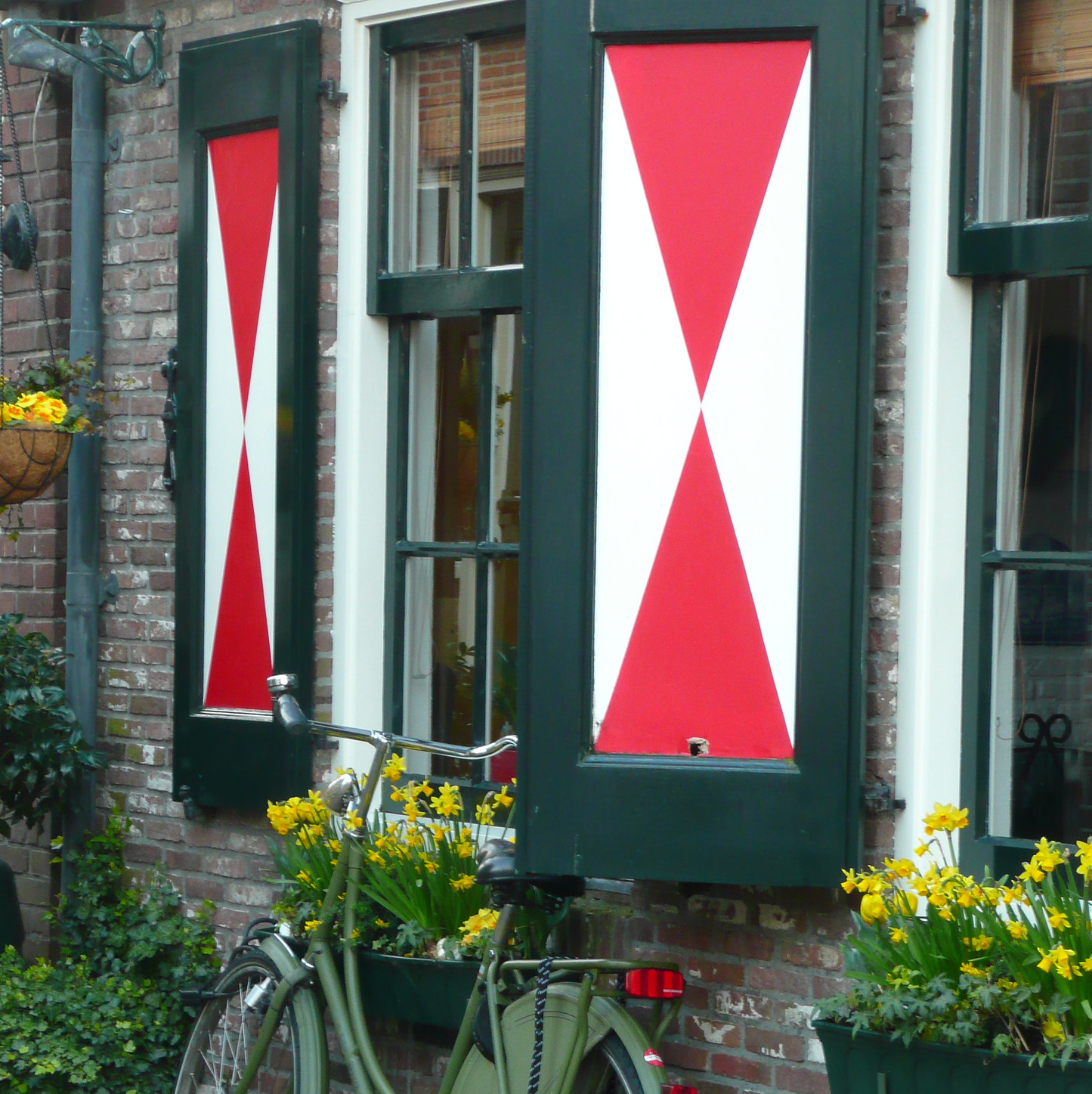
The first time my mom took me to the Netherlands when I was about 9, I remember seeing cheerful geometric painted window coverings on quaint cottages and elegant town halls alike. When we build a garden shed, I convinced Johnny to paint them with a pattern I love.
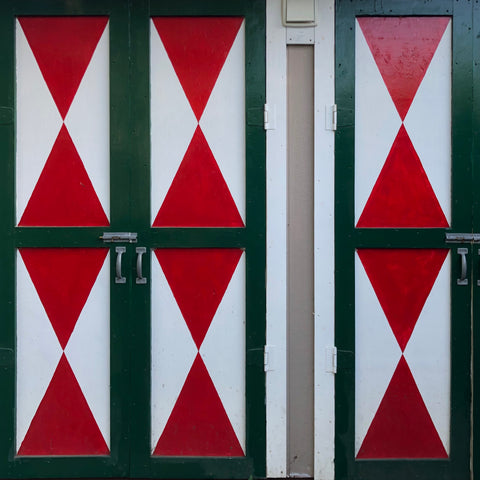
Practically speaking, the thick wooden shutters provide protection from heavy weather, but they also provide a place to display information about geography and identity. Colors are associated with regional history and land ownership.
Here is the set that inspired me:
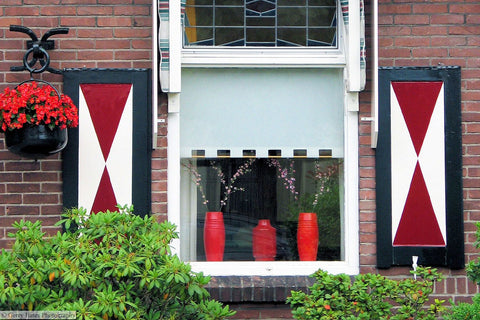
Here are some of the most common shapes, many of which are based on the saltire, or Saint Andrew's Cross (crux decussata), a heraldic symbol in the form of a diagonal cross, like the shape of the letter X in Roman type.

I was 16 when I first visited the town hall in Middelburg in the southwestern province of Zeeland. It is an enormous Gothic building completed in 1520 that hovers protectively over the town square at its feet. As a side note, the weekly market still takes place was founded in 1575.

The nearby coastal town of Vlissingen had a gorgeous town hall from 1594 until it burned in 1809 after being bombed by the British. I bought an etching of it when I lived in the Netherlands for graduate school before knowing about the personal connection.
Now, the Dutch are meticulous record keepers. Nearly 400 years of civic archives are explorable online recording births, baptisms, marriages and deaths, in addition to property management, civic registers and wills. Many records are gone, burned or disintegrated, but MANY remain available to anyone with basic Dutch skills and some time. The name variations offer a challenge, but I made good progress.
On June 16th, 1784, Willem Rietvelt married Suzanna Jansen, they were both listed as bakers. Susanna's parents, Jan Jansen and Laurina de Cam also married there in the winter of 1749, he married Laurina de Cam years later, a parallel branch of the family also celebrated in this building. On the 12th of July in 1786, Isaac Timmermans, who worked as a tailor's apprentice, married Jacoba Catharina Barbier in this building. Jacoba's parents Jean Barbier and Krina van Alderwereld married here on April 23rd of 1764. It's amazing that they stood in this very building and signed their names.

Isaac Timmermans and Jacoba Catharina Barbier named their daughter Krina when she was born in 1783. As we survive a strange and historic time, I realize that every generation lives through their own strange times. Krina fascinates me.
In 1795, the French moved to occupy the strategically important city of Vlissingen, located at the mouth of the Scheide River, which lead to Antwerp. The Treaty of Fontainebleau officially annexed Vlissingen to France. On January 14th, 1808, when Krina was 24, there was a huge storm and the dikes broke, flooding the entire town and killing 31 people. What was this night like for Krina and her parents? This engraving by Johannes Koekoek shows the scene. What terror to feel in the darkness as the sea washes in.
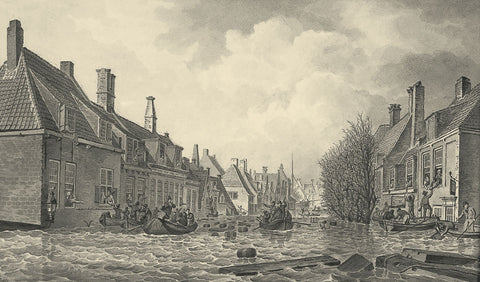
The next year in July of 1809, the city was bombed by the British to attack the occupying French army. There was little fighting, but great loss of life due to what was called "Walcheren Fever" - probably a combination of typhoid and malaria. How terrifying to live through a bombing and see the city go up in flames. That must have been a long night and weeks of strange transition and rebuilding.

In 1810, Napoleon further moved to occupy the Netherlands. All records during the later occupation are in French instead of Dutch. Names are changed from Willem to Guilliome. He ended the tradition of patrynomic naming (John-son etc) and required people to use last names by 1811.
Crina did not marry, but she had three children with three different men in 1812, 1817 and 1822. Each birth record shows her midwife (vroede vrouw / sage femme) as well as two witnesses. Though she is noted as unmarried and listed as a "werkster" or worker. In each case, there are two witnesses in addition to the midwife. In 1812, she named her first son Joseph Daniel for the first witness Jozeph Daniel Tambourni - this one is in French. I dug a bit and found that Guisseppe Daniele Tambourini was born in 1777 in Monaco and he was a corporal in Napoleon's army. The second witness was a French sergeant. Her second son Isaac, born in 1818 is named after the second witness, who is the official town messenger. Her daughter Jacoba Lena was born in 1822 (named for her mother) is witnessed by a police agent (who was married and had kids before and after Lena's birth).
Here is an 1813 painting of Napoleon's arrival in the Amsterdam surrounded by lots of fancy powerful men by artist Mattheus Ignatius van Bree.
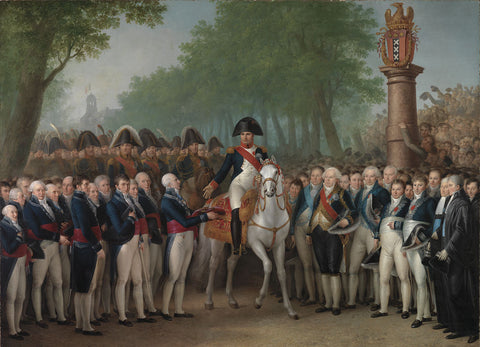
I have done enough research to know that Crina's circumstances are not common. People often married and remarried to pool resources and help care for children. From the civic registries I know that Crina moved fairly often but always maintained her own house with all three of her children. She was never in the poor house. Interestingly, for several years she names the children with the last names Kruger, Tambourni and Timmermans for her daughter. Joseph Daniel signed up for the military in 1831 and has brown hair and brown eyes. From Isaac's 1836 military record, we know he has blue eyes and is blond, works as a smith, and still lives with his mother. By 1843 he is engaged and a bailiff. Joseph Daniel worked as a mason and each of Crina's three children named their children after each other and their mother. Evidence suggests they stuck together. This FASCINATES me. Later all three are known by her maiden name, Timmermans. Each of her children went on to work and marry and have children.
Here is my Great Great grandfather, Isaac (the bailiff) with his wife, Maria Reitveld.

So now the speculation. Crina lived with three children of three different men and was witnessed in each case by people affiliated with government and military. If the convention of naming the father on the birth certificate holds true in combination with her using the last names of these witnesses for her sons seems to clearly indicate that these were the fathers. Was it conventional to name the father - even if he was married to someone else - to assure civic order and correctness in record-keeping? Children born out of wedlock were given fewer legal rights than other children. This also means that she had three kids - one of whom was of Mediterranean descent - one wonders what her world was like. After poking around more in the Zeeuwse Archief, I found that Crina's mother's sister also had two children out of wedlock - though she was married and they were recorded officially as bastards or "onecht kind." One wonders if they were liberated women or worked in the sex industry or maybe they were just human beings who lived before reliable birth control. One wonders with the statistics around early 19th century pregnancy if there were other lost pregnancies. Who was this woman!? What was her world like.


